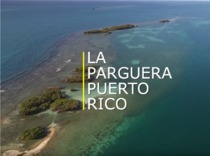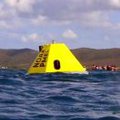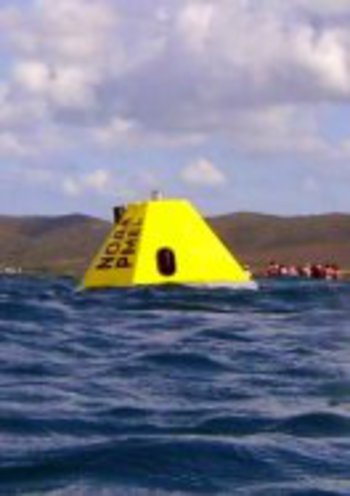Tracking Ocean Acidification in Puerto Rico: A Video Journey
Since 2008 NOAA’s Ocean Acidification Observing Network buoy has been collecting data in La Parguera, Puerto Rico where oceanographic studies of chemistry, biology, geology, and physics of the Caribbean Sea have been conducted for more than 50 years. Below is a video ocean acidification research in Puerto Rico.
Transcript of the video above:
00:07 Since 2008 the NOAA’s Ocean Acidification program (OAP) buoy has been installed in La Parguera, Puerto Rico where oceanographic studies of chemistry, biology, geology, and physics of the Caribbean Sea have been conducted for more than 50 years.
00:35 Atmospheric carbon dioxide (CO2) levels have increased by 35% since the Industrial Revolution. This “greenhouse gas” affects the lives of animals and plants and regulates the temperature of the planet. Changes in land use such as deforestation and emissions from fossil fuels from the burning of oil, coal, and natural gas have led to a dramatic increase in the amount of CO2. This increase affects the chemistry of the ocean and consequently marine life.
01:15 Captain Jorge “Cachi” Hilerio, Scuba Diving Instructor, Paradise Scuba and Snorkeling Center, speaking: I have heard about acidification oceanic but I don't know exactly what it is or who is working on it.
01:24 Melissa Melendez, MS, Field Operations Coordinator speaking: NOAA’s Coral Reef Monitoring Program established La Parguera as a fixed station where data will always be collected with a stationary buoy. Station 3 means that we have a set number of parameters that will be monitored. One of them would be the socio-economic which considers how people view the effects of ocean acidification and how it effects them.
01:50 Captain Jorge “Cachi” Hilerio speaking again: Tourists come to La Parguera to see the diversity of live corals species often in shallow waters.
01:59 Melissa Melendez speaking again: Another set of parameters would be biology and how biological organisms will be affected by ocean acidification. Chemical data is the third set of parameters that are taken because the effects of acidification and the process of acidification is a chemical process that occurs in water when atmospheric CO2 dissolves in the seawater and reacts with water and carbon ions which produces carbonic acid. More acidic water interferes with calcification. We measure acidity on a pH scale from 0 to 14 to measure how acidic or basic a solution is. Values less than 7 are more acidic and values greater than 7 are more basic or alkaline. Many of our marine organisms use calcium carbonate to build their skeletons and shells making them highly susceptible to changes in ocean acidification. Crustaceans like spiny lobster, bivalves such as oysters and mussels and shelled animals such as conch and reef builders like corals can be affected by acidification. The oceanic increase in acidity reduces or slows the calcification process.
03:27 The objective of the buoy is to quantify the effects of acidification in coral reef areas on long and short term scales. With this buoy we have 9 to 10 years of data so we can see trends in which direction it goes increasing or decreasing which is why you need long-term observations.
03:51 Captain Jorge “Cachi” Hilerio speaking again: Thanks to scientific studies and according to the information they collect one can determine how wise it is to work in these certain areas underwater.
04:07 Melissa Melendez speaking again: The ocean acidification buoy in La Parguera is part of a global effort of monitoring the status of acidification in different areas Here in La Parguera, the buoy is one of the two buoys in the Caribbean that monitors acidification of the oceans.
Measured Data includes:
- CO2 in the water
- CO2 in the air
- Temperature
- Salinity
- Chlorophyll
- Oxygen (O2)
- pH in the ocean
04:51 Thanks to these observations we can also establish other types of collaborations to expand our projects. These include NOAA’s Ocean Acidification Program, Caribbean Ocean Observing System (CariCOOS), and the marine science department here at the University of Puerto Rico, Puerto Rico Sea Grant and the University of New Hampshire where I am doing my PhD. Through this project, we are trying to better understand the variability and how the observations taken from the buoy are different from those in other areas.
05:30 We want to create a map of these coastal areas, especially areas with reefs that are vulnerable due to acidification; to understand a little more about acidification in the bioluminescent bay. And to understand more about processes like the arrival of Sargassum and its effects on acidification and levels of chemistry of that austere ocean.
05:51 We have placed five Calcification Accretion Units (CAUs) at each monitoring station. These units are plates for measuring the long-term calcification rate. This study provides information on rates of aggression and serves as a basis to detect changes in the chemistry of the sea water due to ocean acidification.
06:16 We can compare the data we collect here in La Parguera with other areas of coral reefs in the Caribbean because we have the same ecosystems with the same organisms and areas that are close to the coast that are also colonized by the same types of mangrove ecosystems and sea grasses. So we can use these data to characterize other areas in the Caribbean.
06:44 Captain Jorge “Cachi” Hilerio speaking again: I have spoke with some of the people who work on the buoy and now I understand its use and I can explain to the people in reality about how this is developing and how it is important to have that buoy and why, according to that data, you can take conservation measures.
07:15 How can you help?
Organisms affected by ocean acidification are also affected by marine litter, by degradation of water quality, and physical disturbances. To the extent that we reduce these impacts we help protect marine organisms that are experiencing the stress caused by ocean acidification. You can help protect marine organisms by getting involved in environmental projects in your community!
07:51 For more information on how to reduce your carbon footprint:
- http://cotap.org/reduce-carbon-emissions/
- http://www.epa.gov/ghgemissions/household-carbon-footprint-calculator




